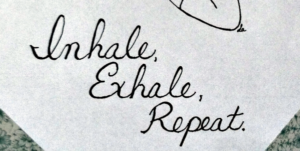 I recently attended a meditation retreat; a single day dedicated to chanting and meditation, to turning in.
I recently attended a meditation retreat; a single day dedicated to chanting and meditation, to turning in.
Of course, it can be healthy, in general, to take a break from routines and habitual busyness to do such things. The larger benefits of this day, I imagine, will unfold over time.
The key thrust of the program was to encourage people to meditate. Rather than using meditation for centering or performance enhancement (a focus not ignored in business or sports), my perspective on the true power of meditation is more spiritual.
The goal of meditation, I believe, is to experience existence outside of one’s ego, to let go of one’s dependence on circumstances in order to be happy and to identify with the limitless and eternal rather than defining who we are based on politics or class, gender or profession.
Whether this approach to meditation is of interest to you or if you are curious about meditation to improve your golf swing or lessen anxiety, it’s common for beginning meditators to start with their BREATH.
Ah breathing…
It sounds so simple, and yet, as we often learn in a level one yoga class, many of us don’t breathe correctly. It’s hard at forty or older to allow your belly to fully expand when you’ve spent most of your life holding your stomach in.
When a well-meaning meditation instructor follows up on tips for how to sit by saying, Watch your breath, my battle with my breath kicks in to a higher gear.
I’m not a visual person to begin with. I have to play around with any metaphorical references to golden particles of light filling my lungs, filling all sorts of body cavities, and then being expelled in long exhalations. I can’t seem to conjure up the intended visuals but I get the gist of instruction.
Be conscious of your life force. Be aware of natural boundaries, with insides and outsides. Be present to the sensation of these boundaries melting away.
Breathe in deeply. Let your breath out slowly…
It’s not that I take breathing for granted.
I have two sisters that had experiences with lung cancer. One sister, older by seven years or so, after diagnosis five years ago, had two lobes of one lung removed. She had to re-learn how to breathe with less capacity. Another sister, only one year older, died 16 years ago.
As children, that sister, unhappy to share a bedroom with her snoring younger sister, used to pose a strange rhetorical question to me, Must you breathe?
Was she merely tired of listening to the unconscious waves of my respiration? Was she upset at me just for being alive? Was she questioning my right to occupy space on this planet as she questioned whether air should fill my lungs?
No, I never had an easy relationship with my own breath. I still find myself holding my breath when I’m excited or deep in concentration. I’m aware of habits to take in just barely as much air as I need, not as much as life might be offering.
….But I want to experience samadhi, this state of total absorption in both the present and the eternal. I want to lose preoccupation with accomplishments and judgments and just BE.
From others before me who have had the same goal, I understand this place to be at the intersection of where one’s breath meets the heart, the heart of everything. There are no road signs, but I trust that I’ll know it when I get there.
Respiration keeps the body alive, but maybe, more importantly, breathing with this goal, gives life meaning.
Even though I’ve been at it for sixty years, I guess I have to practice breathing.
First thing in the morning (before I have tea and take India out for her walk), when the sound is turned down during a commercial break, or when I’m wiping my kitchen countertop –- It’s a good thing that I can practice every day.
Recognizing the importance of breathing, deeply and CONSCIOUSLY, even while the basic function occurs automatically, is no small thing.


Leave a comment